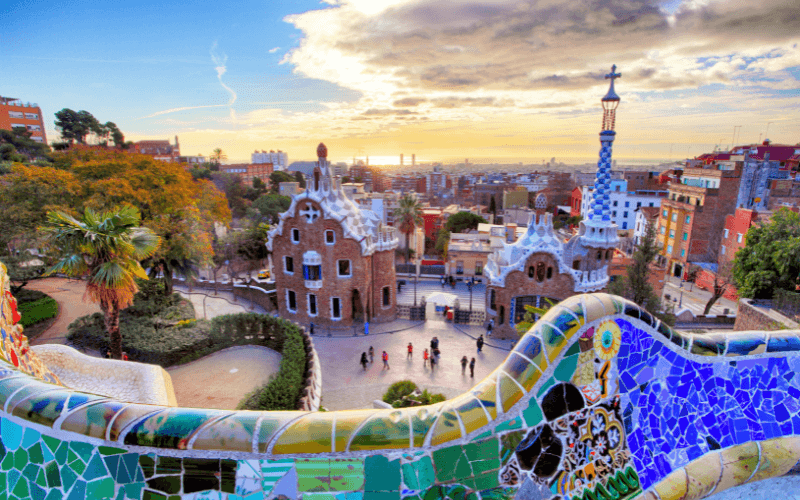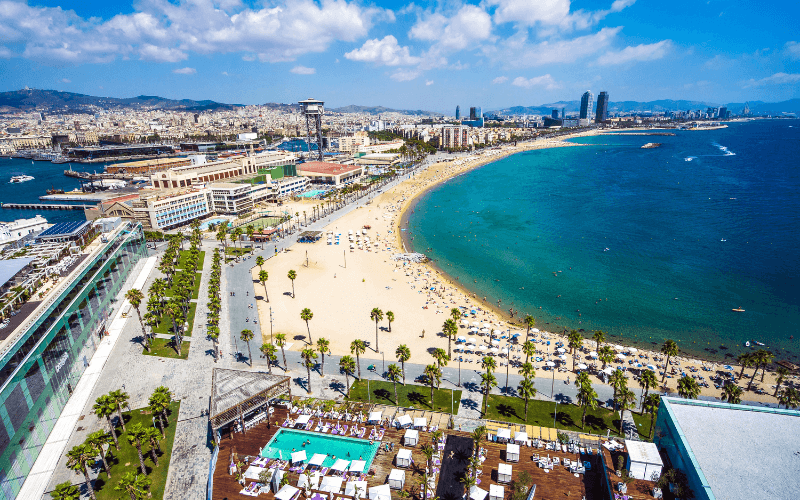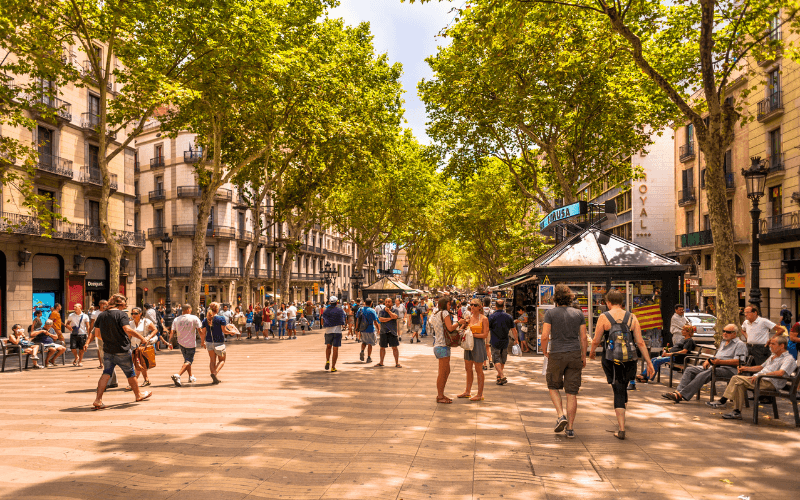
Spotlight On Spain: Barcelona
Expat Tips
Published: 05 June 2023 14:35 CET
Updated: 07 April 2025 14:35 CET
Nestled on the northeastern coast of Spain, Barcelona stands as a captivating metropolis renowned for its unique blend of rich history, thriving economy, efficient transportation systems, and a plethora of attractions that cater to all interests. This vibrant city, the capital of Catalonia, has etched its name on the global stage as a must-visit destination.
With roots dating back to ancient Roman times, Barcelona has witnessed a fascinating evolution throughout the centuries. Its strategic location along the Mediterranean Sea has played a crucial role in shaping its cultural identity and economic significance. From Roman settlement to mediaeval trade hub and modern cosmopolitan centre, Barcelona's history has left an indelible mark on its streets, architecture, and way of life.
Today, Barcelona stands as a thriving economic powerhouse in Spain. The city boasts a diverse economy, with sectors such as tourism, finance, technology, and manufacturing contributing to its vitality. The entrepreneurial spirit and innovation-driven mindset have made Barcelona a hub for startups and a sought-after destination for international businesses.
Transportation within the city is efficient and well-connected. A comprehensive public transportation network, including metro, buses, trams, and trains, seamlessly links Barcelona's neighbourhoods and surrounding regions. This accessibility makes exploring the city and its surroundings convenient and allows visitors to discover its many treasures with ease.
When it comes to things to do in Barcelona, the options are seemingly endless. The city offers a vibrant arts and culture scene, with world-class museums, galleries, and theatres. From the awe-inspiring architectural marvels of Antoni Gaudí, such as the iconic Sagrada Familia and Park Güell, to the narrow winding streets of the Gothic Quarter, Barcelona's architectural treasures are a testament to its rich heritage.

Outdoor enthusiasts can enjoy the Mediterranean climate and indulge in activities like strolling along the picturesque beaches, exploring the lush parks and gardens, or hiking in the nearby Montjuïc Mountain. Food lovers will relish the opportunity to savour delicious Catalan cuisine, with its emphasis on fresh seafood, tapas, and regional specialties.
As we delve deeper into this article, we will explore the diverse population of Barcelona, its favourable climate, renowned universities, and an array of must-visit attractions that make this captivating city an irresistible destination for travellers from around the world. Join us on a journey to uncover the hidden gems and cherished landmarks that make Barcelona a truly unforgettable experience.
Population of Barcelona by Nationality
Barcelona, with a staggering 359,480 foreign residents, holds the highest number of foreign nationals among all municipalities. It witnessed an increase of 11,178 foreigners compared to the previous year. Following closely behind is L'Hospitalet de Llobregat with 58,037 foreign nationals, while Badalona has 35,215 and Terrassa has 31,516 foreign residents.
Analysing the continental origin of these populations, the European segment experienced the largest absolute increase, with 13,906 individuals. The populations from America and Oceania also grew, although to a lesser extent. Conversely, the Asian and African populations saw a decline.
Examining the nationalities contributing to these figures, noteworthy increases were observed among individuals from Italy (6,315), Colombia (4,594), Argentina (2,230), France (2,147), and Venezuela (1,742). On the other hand, the nationalities that experienced the most significant decreases were Morocco (2,914), Bolivia (2,360), Romania (1,176), Brazil (945), and India (683).
The foreign population residing in Catalonia exhibited remarkable diversity, representing over 170 nationalities. The Moroccan community stood out as the largest, with 235,278 individuals, accounting for 18.5% of the total foreign population. Following closely behind was the Romanian population, with 86,528 individuals, representing 6.8%. The Italian population (76,826) and the Chinese population (63,228) occupied the next positions, representing 6.0% and 5.0%, respectively.
In terms of regional distribution within Catalonia, the Moroccan population emerged as the leading nationality in 28 counties. Meanwhile, the Romanian population held the leading position in eight counties and Aran. Notable nationalities in specific regions included Italians in El Barcelonès, Colombians in La Cerdanya, Indians in La Garrotxa, Portuguese in L'Alt Urgell, and Malians in El Moianès.
Source: https://www.idescat.cat
Weather and climate
Barcelona enjoys a Mediterranean climate characterised by mild winters and warm summers. Here's a breakdown of the weather and climate in Barcelona.
Weather: Barcelona experiences pleasant and comfortable weather throughout the year, making it an appealing destination for visitors. The city sees a good amount of sunshine and relatively mild temperatures.
- Spring (March to May): Spring in Barcelona brings mild temperatures, with average highs ranging from 15°C (59°F) to 20°C (68°F). It is a great time to visit as the city starts to bloom with vibrant colours, and the weather is generally pleasant.
- Summer (June to August): Summers in Barcelona are warm and sunny. Average daytime temperatures range from 25°C (77°F) to 30°C (86°F), occasionally reaching even higher. It is the peak tourist season, and the city is bustling with visitors enjoying the beaches, outdoor activities, and various festivals.

- Autumn (September to November): Autumn in Barcelona sees comfortable temperatures, with average highs ranging from 20°C (68°F) to 25°C (77°F). It is a lovely time to explore the city as the summer crowds begin to thin, and the weather remains pleasant.
- Winter (December to February): Winters in Barcelona are mild compared to other European cities. Average daytime temperatures range from 10°C (50°F) to 15°C (59°F), with cooler evenings. While it can occasionally get chilly, snow is rare in the city. Winters attract fewer tourists, making it a quieter time to visit.
Climate: Barcelona's climate is influenced by its Mediterranean location, with the Mediterranean Sea playing a moderating role. The city experiences relatively mild and humid winters, while summers tend to be hot and dry. The overall climate characteristics include:
- Average annual temperature: Barcelona's average annual temperature is around 16°C (61°F).
- Rainfall: The city receives most of its rainfall during the autumn and spring seasons. Summers are typically drier, while winters may see occasional rainfall.
- Sea influence: The proximity to the Mediterranean Sea helps moderate extreme temperatures, keeping summers from becoming excessively hot and winters from being too cold.
It's important to note that these weather and climate patterns are general guidelines, and specific conditions can vary from year to year.
Learn more about the weather in Spain.
Transportation
Barcelona boasts a well-developed and efficient public transport system that offers residents and visitors a variety of convenient options for getting around the city. The transportation network comprises a combination of metro lines, buses, trams, and commuter trains, providing extensive coverage throughout Barcelona and its surrounding areas.
The backbone of the public transport system is the Barcelona Metro, which consists of multiple lines that connect various parts of the city. The metro network is efficient, punctual, and widely used by locals and tourists alike. With over 160 stations, the metro offers quick and reliable transportation to popular landmarks, neighbourhoods, and major transportation hubs. Trains generally operate from 5:00 AM until midnight on weekdays, with extended service on weekends and holidays.
In addition to the metro, Barcelona has an extensive bus network that complements the underground system. Buses cover a vast area, reaching neighbourhoods and destinations not served by the metro. They operate on a comprehensive schedule, often running until late at night, and provide an excellent way to explore the city at a more leisurely pace. Barcelona's buses are equipped with modern amenities, such as air conditioning and accessibility features for individuals with reduced mobility.
For shorter distances and inner-city travel, trams are a convenient mode of transportation. The tram network serves various parts of the city, including popular areas like the waterfront and major avenues. Trams offer a smooth and scenic journey, providing passengers with a comfortable way to navigate through Barcelona's streets.
For those venturing beyond the city limits, the commuter train system, known as the Rodalies, offers connections to neighbouring towns and regions. These trains provide an efficient means of transportation for both daily commuters and visitors looking to explore the wider Catalonia area. The Rodalies network connects Barcelona with popular destinations such as Sitges, Montserrat, and the Costa Brava.
To use Barcelona's public transport system, it is advisable to purchase an integrated ticket, such as the T-10 card, which allows multiple journeys on various modes of transport within a specific zone. Additionally, the Barcelona Card offers unlimited travel on public transportation, along with discounts on attractions and museums.
Barcelona's public transport system is known for its reliability, frequency, and extensive coverage. Whether you're heading to iconic landmarks like Sagrada Família or exploring the city's diverse neighbourhoods, the public transportation network provides an efficient and cost-effective way to navigate Barcelona and experience its vibrant culture.
Places to Visit
Barcelona offers a wide range of tourist attractions and activities for visitors to enjoy. Here are some of the main highlights and things to do in the city:
1. La Sagrada Familia: A masterpiece designed by renowned architect Antoni Gaudí, this basilica is an iconic symbol of Barcelona. Its unique and intricate design makes it a must-visit attraction.
2. Park Güell: Another Gaudí masterpiece, this park is a UNESCO World Heritage Site. It features stunning architectural elements, colourful tile work, and beautiful views of the city.
3. Gothic Quarter (Barri Gòtic): Explore the historic heart of Barcelona in the Gothic Quarter. Wander through its narrow mediaeval streets, visit the Barcelona Cathedral, and discover charming squares and hidden corners.
4. Las Ramblas: This bustling boulevard pictured below is famous for its vibrant atmosphere, lined with shops, cafes, street performers, and flower stands. Take a leisurely stroll, soak in the lively ambiance, and explore the nearby La Boqueria Market.

5. Park de la Ciutadella: Escape the city bustle in this picturesque park, which is ideal for picnics, leisurely walks, and boating on the lake. It also houses attractions like the Barcelona Zoo and the Catalan Parliament.
6. Casa Batlló and Casa Milà (La Pedrera): Explore two of Gaudí's residential masterpieces. Casa Batlló showcases stunning architectural details, while Casa Milà offers a glimpse into the artist's innovative designs.
7. Montjuïc: A hill overlooking the city, Montjuïc is home to several attractions, including the Montjuïc Castle, the Magic Fountain, and the Montjuïc Olympic Stadium. Enjoy panoramic views, visit museums, and explore the beautiful gardens.
8. Camp Nou: Football fans shouldn't miss a visit to the Camp Nou stadium, home to FC Barcelona. Take a tour of the stadium, visit the museum, and soak up the football atmosphere.
9. Picasso Museum: Discover the works of the legendary artist Pablo Picasso at this museum, which houses one of the most extensive collections of his artworks.
10. Beaches: Barcelona boasts several beautiful sandy beaches, such as Barceloneta Beach, Nova Icaria Beach, and Bogatell Beach. Relax, swim, or engage in watersports under the Mediterranean sun.
These are just a few highlights, and Barcelona has much more to offer, including vibrant nightlife, culinary delights, and a thriving arts scene. Whether you're interested in architecture, history, art, or simply soaking in the city's unique ambiance, Barcelona has something to cater to every visitor's taste.
Barcelona Universities
Barcelona is indeed a popular destination for international students, offering a rich academic environment and a vibrant cultural scene. The city is home to several prestigious universities and educational institutions that attract students from around the world. Here are some of the main universities for international students in Barcelona:
1. University of Barcelona (Universitat de Barcelona): As one of the oldest universities in the world, the University of Barcelona is highly regarded for its academic excellence. It offers a wide range of undergraduate and postgraduate programs across various fields of study.
2. Pompeu Fabra University (Universitat Pompeu Fabra): Known for its strong focus on social sciences, humanities, communication, and economics, Pompeu Fabra University is a leading institution in Barcelona. It is often ranked among the top universities in Spain and Europe.
3. Autonomous University of Barcelona (Universitat Autònoma de Barcelona): Located in the outskirts of the city, the Autonomous University of Barcelona is known for its diverse range of programs and strong research output. It offers a multicultural environment and has a large international student community.
4. Polytechnic University of Catalonia (Universitat Politècnica de Catalunya): Specialising in engineering, architecture, and technology-related fields, the Polytechnic University of Catalonia is a renowned institution for students seeking studies in these disciplines.
5. ESADE Business School: Considered one of Europe's top business schools, ESADE offers undergraduate, postgraduate, and executive education programs in business and management. It is known for its international outlook and strong industry connections.
6. Barcelona Institute of International Studies (IBEI): IBEI is a research and educational institute that focuses on international relations, political science, and economics. It offers master's programs that attract students interested in global affairs.
These universities provide a wide range of programs taught in English, making them accessible to international students. Barcelona's vibrant and cosmopolitan atmosphere, along with its cultural heritage, makes it an attractive city for studying abroad. Additionally, the city's favourable climate, quality of life, and ample opportunities for networking and internships contribute to its appeal as a destination for international students.
Learn more about the top universities in Spain.
CONCLUSION
Barcelona is a captivating city that seamlessly blends a rich history, a thriving economy, efficient transportation, and a wealth of attractions.
Its diverse economy, fueled by sectors like tourism, finance, and technology, has made it a global economic powerhouse and a hub for startups.
The city's efficient public transportation system allows easy exploration of its vibrant arts scene, iconic architecture, and charming streets.
With its Mediterranean climate and picturesque beaches, outdoor enthusiasts can indulge in various activities.
Food lovers can savour delicious Catalan cuisine, while the city's diverse population and vibrant atmosphere make it a popular destination for international students.
Barcelona offers a unique and unforgettable experience, showcasing its cultural richness, economic vitality, and a wide range of attractions for visitors to enjoy.



















